Projects
A project in Digital Hub is a container for everything (code, assets, configuration, ...) that concerns an application. It is the context in which you can run functions and manage data and artifacts. Projects may be created and managed from the UI, but also by using DH Core's API using, e.g, Python SDK.
Managing Projects via UI
In the following sections we document the Project management through UI available using the Digital Hub Console.
CRUD
Here we analyze how to Create, Read, Update and Delete Projects using the UI, similarly to what happens with the SDK
Create
A project is created pressing the button CREATE in the Homepage od the Console.

After pressing the button, the dialog asking the Project's parameter is shown:
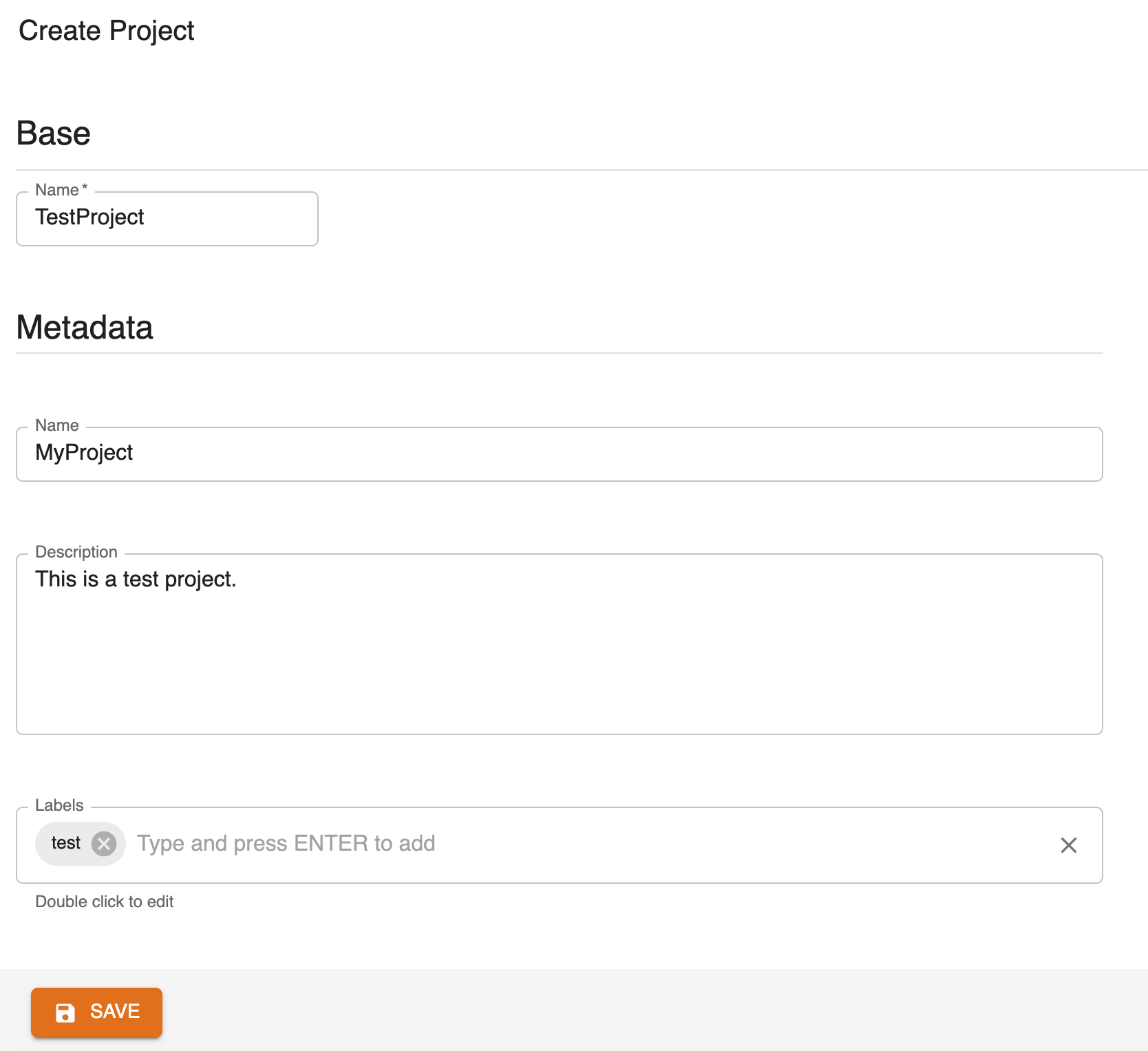
It has the following mandatory parameters:
name: the name of the project, it is also the identifier of the projectdescription: a human readable description of the project
The other Metadata parameters are optional and mutable after the creation:
name: the name of the projectdescription: a human readable description of the projectupdated: the date of the last modification made to the projectlabels: a list of labels (strings)
Pressing on the Save button, the project is added to the list of the projects in Homepage
Read
In the Home Page are listed all the projects present in the database. The tile shows:
name: the name of the projectid: the identifier of the projectcreated: the date of the creation of the projectupdated: the date of the last modification made to the project
On the bottom the button for Open and enter in the Project and the Delete
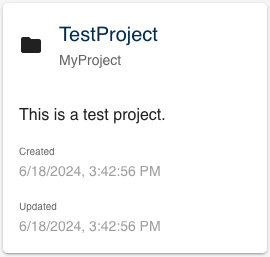
Clicking on the Open button, the following Dashboard is shown
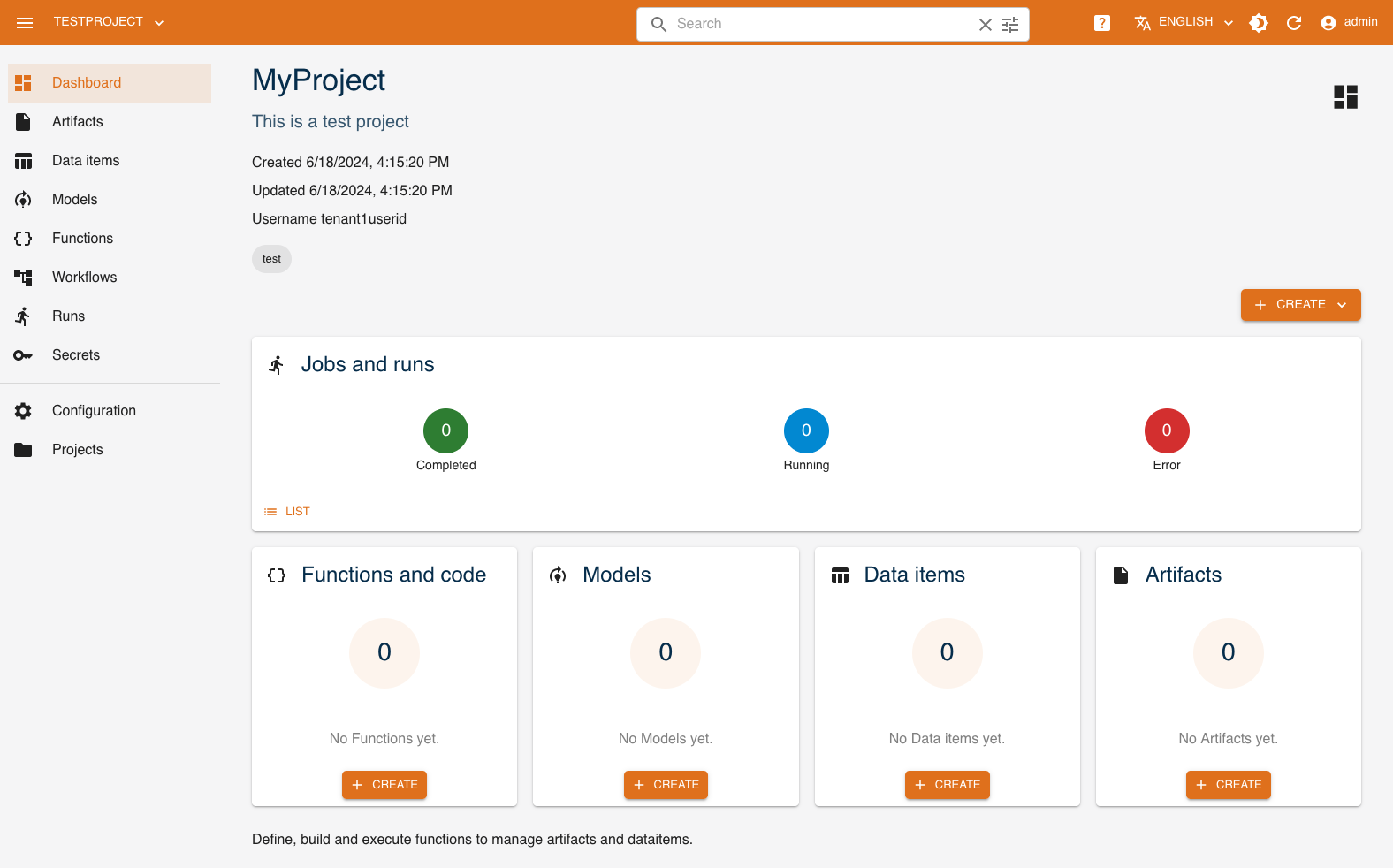
This dashboard reports a summary of the resources associated with the project and a series of features to access the management of these resources.
Artifacts: the number and the list of the last Artifacts createdData items: the number and the list of the last Data items createdFunctions and code: the number and the list of the last Functions createdJobs and runs: the status and list of runs performed
From any page of the dashboard it is possible to change the project by selecting from the menu at the top of the bar
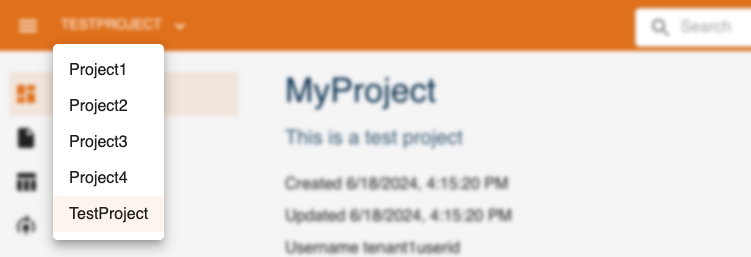
Update
You can update a project Metadata pressing the button Configuration in the side Menubar.

Pressing the Edit button on the top right of the page the form for editing the Metadata values of the project is shown.
In the example below, the labels test and prj1 are added
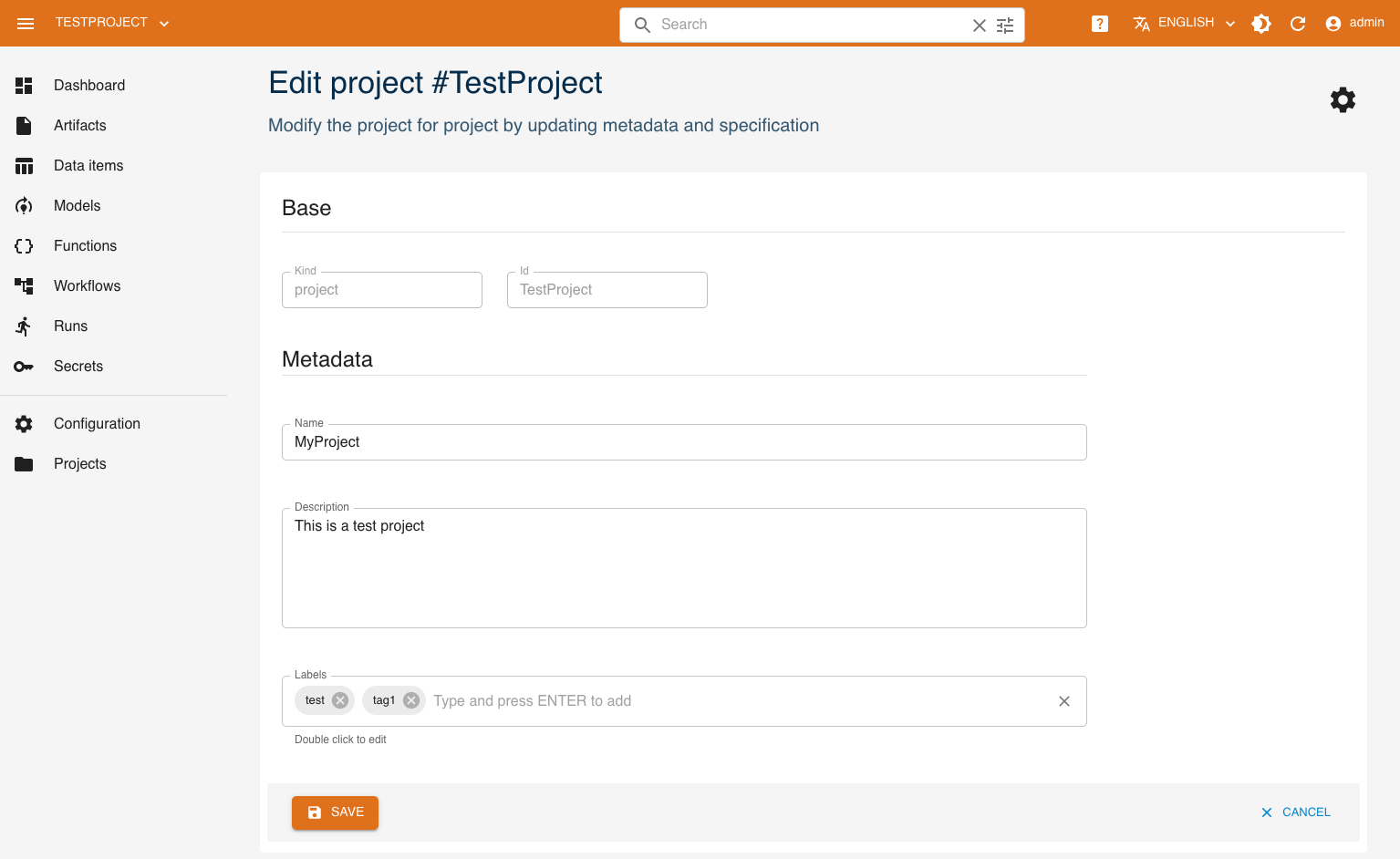 After the modification, pressing Save the new configuration is stored
After the modification, pressing Save the new configuration is stored
Delete
You can delete a project from the Home page and from the Configuration pressing the Delete button.
For confirm the choice of deleting, insert the name of the project in the dialog
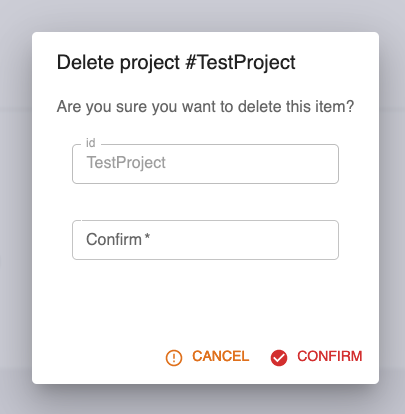
Managing Projects via SDK
In the following sections we document the project CRUD methods available in the SDK and the methods exposed by the Project entity.
CRUD
Here we analyze how to create, read, update and delete projects using the SDK.
Create
A project is created with new_project() method. It has the following mandatory parameters:
name: the name of the project, it is also the identifier of the project
The other parameters are optional:
context: path where project can export yaml files locallydescription: a human readable description of the projectsource: a Git repository URL where lies the project codelabels: a list of labelslocal: a boolean value, ifTruethe project will be managed without Core backend. Defaults toFalseconfig: a dictionary containing the project configuration like user and password for basic auth or a bearer tokensetup_kwargs: a dictionary containing the project hook setup argumentskwargs: a list of keyword arguments passed to the client that comunicate with the backend
Example:
import digitalhub as dh
project = dh.new_project("my-project", context="./", description="my new project")
Config
The config parameter can be used to provide a dictionary containing the project configuration like user and password for basic auth or a bearer token. The format of the dictionary for basic auth must be as this:
{
"user": "user",
"password": "password"
}
The format of the dictionary for bearer token must be as this:
{
"access_token": "token"
}
Setup kwargs
The setup_kwargs parameter can be used to provide a dictionary containing the project hook setup arguments. The concept behind this parameter is that at the beginning of the project lifecycle, the project can be configured with an hook script that will be executed when the project is created / got.
First of all, the configuration script MUST comply with the following format:
- It must be a Python script named
setup_project.pyinside the project context directory. - It must contain an handler (a python function) named
setupas entrypoint. - The
setupfunction must accept aProjectinstance as the only positional argument. setup_kwargsmust be passed as keyword arguments to thesetupfunction.
The project setup will create a .CHECK file at the end of the setup function execution. This sentinel file is used to indicate that the project is set up and new executions will be ready.
A use case scenario can be the instantiation of entities used by the user like artifacts or functions.
Example:
setup_kwargs = {
"some_arg1": "arg1",
"some_arg2": "arg2"
}
# Setup script
def setup(project, some_arg1=None, some_arg2=None):
# Do something with project and args
Read
You can read a project with three methods, from remote backend with get_project(), from local directory with import_project() or from either with load_project().
Get project
With get_project() you can load a project from the backend. The method requires the following manadatory parameters:
name: the name of the project
The other parameters are optional:
local: a boolean value, ifTruethe project will be managed without Core backend. Defaults toFalseconfig: a dictionary containing the project configuration like user and password for basic auth or a bearer tokensetup_kwargs: a dictionary containing the project hook setup argumentskwargs: a list of keyword arguments passed to the client that comunicate with the backend
Example:
project = dh.get_project("my-project")
Import project
With import_project() you can load a project from a local directory. The method requires the following manadatory parameters:
file: path to the yaml project file
The other parameters are optional:
local: a boolean value, ifTruethe project will be managed without Core backend. Defaults toFalseconfig: a dictionary containing the project configuration like user and password for basic auth or a bearer tokensetup_kwargs: a dictionary containing the project hook setup argumentskwargs: a list of keyword arguments passed to the client that comunicate with the backend
Example:
project = dh.import_project("./my-project.yaml")
Load project
With load_project() you can load a project from the backend or from a local directory.
The method requires either one of the following parameters:
name: the name of the projectfile: path to the yaml project file
If you pass the name, the method will try to load the project from the backend, otherwise it will try to load it from the local directory. Note that both parameters are mutually exclusive and keyword arguments.
The other parameters are optional:
local: a boolean value, ifTruethe project will be managed without Core backend. Defaults toFalseconfig: a dictionary containing the project configuration like user and password for basic auth or a bearer tokensetup_kwargs: a dictionary containing the project hook setup argumentskwargs: a list of keyword arguments passed to the client that comunicate with the backend
Example:
project = dh.load_project(name="my-project")
project = dh.load_project(file="./my-project.yaml")
Create or read
The digitalhub SDK provides a method get_or_create_project() that allows you to create a project if it does not exist. The method has the following mandatory parameters:
name: the name of the project.
The other parameters are optional:
context: path where project can export yaml files locallylocal: a boolean value, ifTruethe project will be managed without Core backend. Defaults toFalseconfig: a dictionary containing the project configuration like user and password for basic auth or a bearer tokensetup_kwargs: a dictionary containing the project hook setup argumentskwargs: a list of keyword arguments passed to the client that comunicate with the backend
Example:
project = dh.get_or_create_project("my-project", context="./")
Update
You can update a project with update_project() method. It has the following mandatory parameters:
project: the project entity that will be updated
The other parameters are optional:
kwargs: a list of keyword arguments passed to the client that comunicate with the backend
Example:
project = dh.update_project(project)
Delete
You can delete a project with delete_project() method. It has the following mandatory parameters:
name: the name of the project
The other parameters are optional:
cascade: a boolean value, ifTruethe project and all the related resources will be deleted from the backend. Defaults toTrue. It is only available in the Core backend.clean_context: a boolean value, ifTruethe project context will be deleted (no more object can be created locally under the project).local: a boolean value, ifTruethe project will be managed without Core backend. Defaults toFalsekwargs: a list of keyword arguments passed to the client that comunicate with the backend
Example:
project = dh.delete_project("my-project")
Project methods
The Project class exposes two basic methods that allow you to save remotely or export locally the project.
Furthermore, according to the SDK digitalhub layer installed, the Project class exposes CRUD methods for a variety of entities.
Save and export
The methods save() and export() are used to save the project on the backend or export the project locally.
Save
The save() method is used to save the project on the backend and it accepts the following optional parameters:
update: a boolean value, ifTruethe project will be updated on the backend
Please note that the save method will usually raise an exception if called without the update parameter on runtime. This is because the project (managed with CRUD SDK methods) should already exists on the backend if exists as object.
Export
The export() method is used to export the project locally as yaml file and it accepts the following optional parameters:
filename: the name of the file to export
Note that the filename must have the .yaml extension. The project will be exported as a yaml file inside the context directory. If no filename is passed, the project will be exported as a yaml file named project_{project-name}.yaml.
According to the SDK digitalhub layer installed, the Project class exposes CRUD methods for a variety of entities.
Entities CRUD
The project acts as context for other entities as mentioned in the introduction. With a Project object, you can create, read, update and delete these entities. The methods exposed are basically five for all entities, and are:
new: create a new entityget: get an entity from backendupdate: update an entitydelete: delete an entitylist: list entities related to the project
Each digitalhub layer exposes CRUD handles different aspects of data and ml entities. Here follows a list of the methods exposed by the Project class for each layer. Please refer to the specific entity documentation for more information.
Core layer
The entity handled by the Project class in the core layer (digitalhub_core) are:
functionsartifactsworkflowssecrets
Data layer
The entity handled by the Project class in the data layer (digitalhub_data) are:
dataitems
Ml layer
The entity handled by the Project class in the ml layer (digitalhub_ml) are:
models